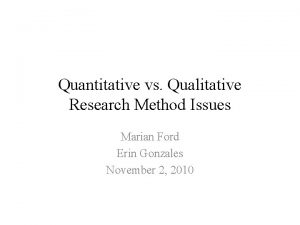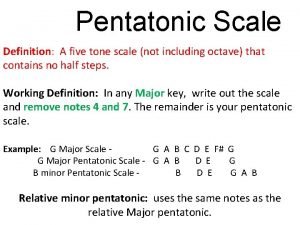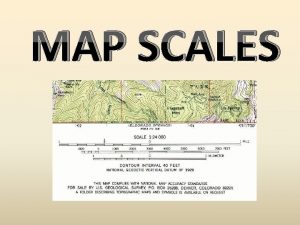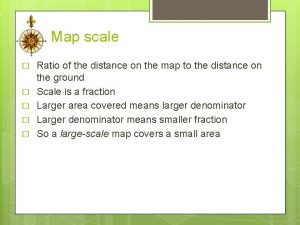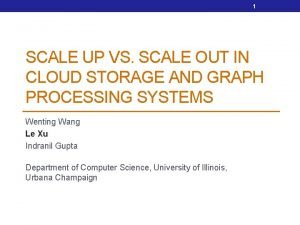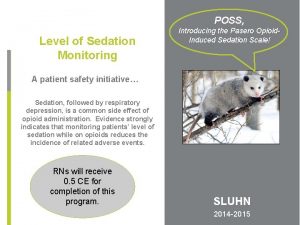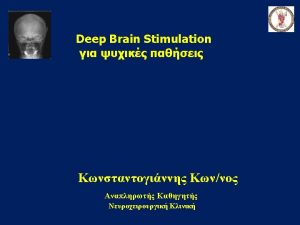Chapter 2 Some Quantitative Formalities Introduction The scale






































- Slides: 38

Chapter 2 Some Quantitative Formalities ◎ ● ◎ ● Introduction The scale of nuclear physics and suitable units The radioactive decay law Multimodal decays Radioactive dating Decay and the uncertainty principle

§ 2. 1 The scale of nuclear physics and suitable units Nuclear measurement • Geiger counter 1. cross-section --- collisions 2. spontaneous change --- decays

Human’s Scale The scale of the known universe and the position of humans within it.

We need some convenient units to do nuclear calculations. The familiar SI units are not handy. Nuclear dimension ~ 10 -15 m Nuclear masses ~ 10 -27 kg

Convenient energy units Atomic Scale ~ e. V Nuclear Scale ~ Me. V (106 e. V) Particle Scale ~ Ge. V (109 e. V)

Useful units and their SI equivalence (1) E total energy p linear momentum M rest mass c speed of light

§ 2. 2 The radioactive decay law Suppose that at time t =0 we have an assembly of a number N(0) of X and at time t a number N(t) survive. Then (1) ω : the transition rate; The probability that a state of a system will make a transition to another state in a period of one second. It is sometimes referred as the decay constant.

(1) Hence (2) This is the radioactive decay law. It is a survival equation giving the number of the state X remaining unchanged until the time t. (3) τ is the mean life time of the state X.

(3) τ is the mean life time of the state X. Mean life time (or mean life) The average life time of an unstable state in a large sample of such states. It is also the time at which the number of states surviving is e 1 of the number present initially.

Decay Mean life Examples of decay processes and their mean lives.

The graphical form of the radioactive decay law showing the relation between mean life (τ) and the half-life (t 1/2) (4)

The detection of radioactivity normally requires the detection of radiation emitted when a nucleus decay. Thus the total intensity detectable at time t is given by (5) or (6) The radioactivity detected by the intensity of particles emitted itself decays at the same rate as does the number of surviving nuclei.

These two equations are strictly probability relations and are subject to statistical fluctuations. (2) (6) Only in the limit of very large numbers do the statistical fluctuations become relatively small. σ: relative fluctuation

Units of radioactivity Curie (Ci) One curie is the amount of a radioactive material in which the number of disintegrations in one second is the same as that of one gram of pure radium (Ra). The number is 3. 7 1010 s-1. Becquerel (Bq) One becquerel is the amount of a radioactive material in which the average number of disintegration in one second is one.

Examples of activities 1. The activity of one person weighing 70 kg is about 10 -7 Ci = 3. 7 103 Bq mainly due to K-40 and C-14. 2. The activity of one cubic meter of air in a dwelling house depends on the nature of the building material and of the ground below, and on the ventilation. It therefore varies, from below 100 Bq to 1000 Bq or higher, mainly due to a radon isotope (Rn-222) and its decay products. Another unit: sievert (Sv) The sievert is defined in a way which takes account of the susceptibility of human tissue to long term risk from radiation. One Sv is approximately 1 J of energy deposited per kilogram of absorbing material in the case of electrons and γ-rays.

The United States maximum permissible occupational whole body -dose is 50 millisieverts (m. Sv) per year.


The effect of certain radiation on a biological system depends on the absorbed dose D and on the quality factor QF of the radiation. The dose equivalent together. DE is obtained by multiplying these quantities Radiation X rays, β, γ QF 1 Low –energy p, n (~ ke. V) 2 -5 Energetic p, n (~ Me. V) 5 -10 α 20 SI unit

Radon Radiation risk: e. g. the Sievert unit of absorbed dose

Radiation Risk

§ 2. 3 Multimodal decays Consider the case that two modes of decay are possible. f 1: the branching fraction of α-decay f 2: the branching fraction of β--decay There are two partial transition rates, ω1 and ω2, for the two decay modes separately. The total transition rate for decay of the parent nucleus is given by (7)

(7) and therefore (8) Its mean life time τ is therefore (9) and (10)

Fill in the last column of this table The decay of the K+ meson Decay mode Branching fraction K+ → μ+ + νμ 0. 635 K+ → π+ + π 0 0. 212 K+ → π+ + π – 0. 056 K+ → π+ + π 0 0. 017 K+ → π0 +μ+ +νμ 0. 032 K+ → π0 +e+ +νe 0. 048 Partial transition rate (s-1)

§ 2. 3 The radioactive dating Carbon dating Biological carbon comes from atmospheric CO 2 which contains the active 14 C (decays to 14 N) in the ratio of 1 atomic part in about 1012 of the stable isotope 12 C. Once fixed biologically, the decay of the 14 C causes a decline in this ratio with a half-life 0 f 5730 years. The 14 C is produced in the atmosphere by the action of cosmic rays and if we believe their intensity has not changed significantly (probably not true !) then the ratio 14 C/ 12 C at the time of biological fixing is the same as it was before 1945 (when atmospheric nuclear weapon testing injected unnatural 14 C into the atmosphere) Thus an assumed ratio at biological fixing and a measured ratio at investigation will give the age of a biological specimen.

Rapa Nui Easter Island Carbon dating method has an evident uncertainness which has to do with the uncertainty of the assumed initial ratio. This uncertainty can be removed by calibrating against other methods of dating when applicable.

§ 2. 4 Decay and the uncertainty principle Mass spectrum of μ+μ- pairs in the PHENIX detector showing clear evidence of the J/Ψ resonance. Image Courtesy PHENIX Collaboration.

Energy spectrum of 182 Hf with its half-life of about 9 million years is a long-lived radionuclide. It is very important for nuclear astrophysics research to detect minute amounts of 182 Hf with AMS (erator mass spectrometry), a ultra-high sensitive nuclear analyzing technique. In present work, the procedures of sample preparation of Hf. F 4 and decontamination of tungsten from the samples have been researched, and the detection efficiencies and energy spectrum of 182 Hf have been measured at CIAE HI-13 tandem accelerator AMS facility. The main interference for the detection is the stable isobar 182 W which can be significantly reduced by injecting negative ion of Hf. F 5-. The ion source efficiency and accelerator transmission efficiency for 182 Hf are 3× 10 -3 and 5× 10 -3, respectively, in CIAE AMS system. The energy spectrum of 182 Hf standard sample, which has been measured with a semi-conductor detector, is showed in Fig. 1. http: //202. 38. 8. 9/nianbao/english 2004/5. htm

Γ A decaying state is a system with an uncertainty of lifetime equal to the mean life (ω-1) of that state. It follows that there is an uncertainty in the total energy given by (11) The uncertainty in energy of an excited state is reflected in the line shape of the radiation emitted in decay to the ground state.

The shape is Lorentzian; it is given by Γ (12) (13) E 0 is the central energy and the expression gives the relative probability of finding an energy E. Γ is the full width at half height, so that Γ/2 is the energy uncertainty. The Lorentzian shape is the transform of the exponential time decay, yielding as expected from the uncertainty principle.

The discussion of “width” If a nucleus is in an excited state, it must discard excess energy it has by undergoing a decay. It is, however, impossible to predict when the decay will actually take place. As a result, there is an uncertainty in time existence of the excited state. Δt = τ associated with the Because of the limited lifetime, it is impossible for us to measure its energy to infinite precision. This phenomenon has an explanation in quantum mechanics!

If we carry out the energy measurement for N nuclei in the same excited state, there will be a distribution of the values obtained. If the value of the ith excited nucleus is Ei, the average <E> is given by (14) An idea of the spread in the measured values is provided by the square root of the variance, Γ (15)

The Heisenberg uncertainty principle says that the product of Γ and τ is equal to The quantity Γis known as the natural line width, or width for short, of a state. (13) Γ It is also a way to indicate the transition probability of a state and is proportional to the inverse of the life time τ.

One can also relate Γ to the probability of finding the excited state at a specific energy. In terms of the wave functions, the decay constant ω may be defined in the following way: (16) For a stationary state, the time-dependent wave function may be written as (17)

To carry such an expression over to a decaying (excited) state, the energy E must be changed into a complex quantity, (18) The time-dependent wave function now takes the form (19)

An excited state is the one without a definite energy its wave function should be a superposition of components having different energies, (20) where a(E) is the probability amplitude for finding the state at energy E. From equations (19) and (20)

so that (21) In the equation (21) we recognize that e-ωt/2 is the Fourier transform of a(E). Therefore (22)

The probability for finding the excited state at energy E is given by the absolute square of the amplitude, (23) Γ with (13) Lorentzian shape curve

~ The End ~
 Abrupt blunt with no formalities
Abrupt blunt with no formalities Abrupt blunt with no formalities
Abrupt blunt with no formalities Efsweb
Efsweb European market access database
European market access database Sometimes you win some
Sometimes you win some God when you choose to leave mountains unmovable
God when you choose to leave mountains unmovable Ice cream is countable
Ice cream is countable Contact and non contact forces
Contact and non contact forces Fire and ice diamante poem
Fire and ice diamante poem Some say the world will end in fire some say in ice
Some say the world will end in fire some say in ice Some trust in horses
Some trust in horses What is scientific research
What is scientific research Introduction in quantitative research
Introduction in quantitative research Linear geography
Linear geography Parts of a scale
Parts of a scale Pentatonic is a tone scale
Pentatonic is a tone scale Map scale definition
Map scale definition Large scale map
Large scale map Large scale vs small scale map
Large scale vs small scale map Large scale vs small scale map
Large scale vs small scale map Scale up scale out
Scale up scale out Scale up and scale out in hadoop
Scale up and scale out in hadoop Scale drawings/models & scale factor
Scale drawings/models & scale factor Engineering 108
Engineering 108 A proportional, three-dimensional model of an object.
A proportional, three-dimensional model of an object. Poss sedation scale
Poss sedation scale Datascale systems
Datascale systems Outer scale protractor
Outer scale protractor Protractor inner and outer scale
Protractor inner and outer scale Representative fraction
Representative fraction Hát kết hợp bộ gõ cơ thể
Hát kết hợp bộ gõ cơ thể Frameset trong html5
Frameset trong html5 Bổ thể
Bổ thể Tỉ lệ cơ thể trẻ em
Tỉ lệ cơ thể trẻ em Chó sói
Chó sói Tư thế worm breton là gì
Tư thế worm breton là gì Alleluia hat len nguoi oi
Alleluia hat len nguoi oi Môn thể thao bắt đầu bằng chữ đua
Môn thể thao bắt đầu bằng chữ đua Thế nào là hệ số cao nhất
Thế nào là hệ số cao nhất












